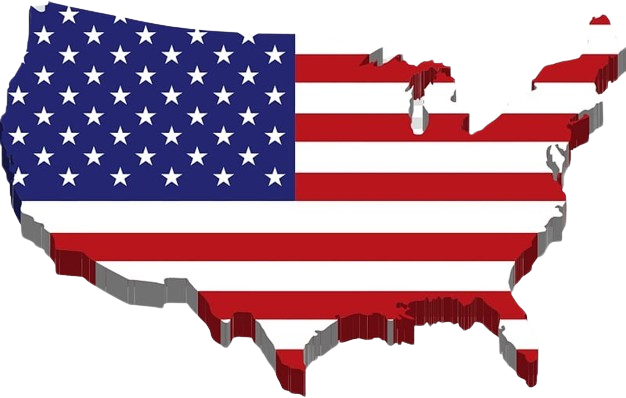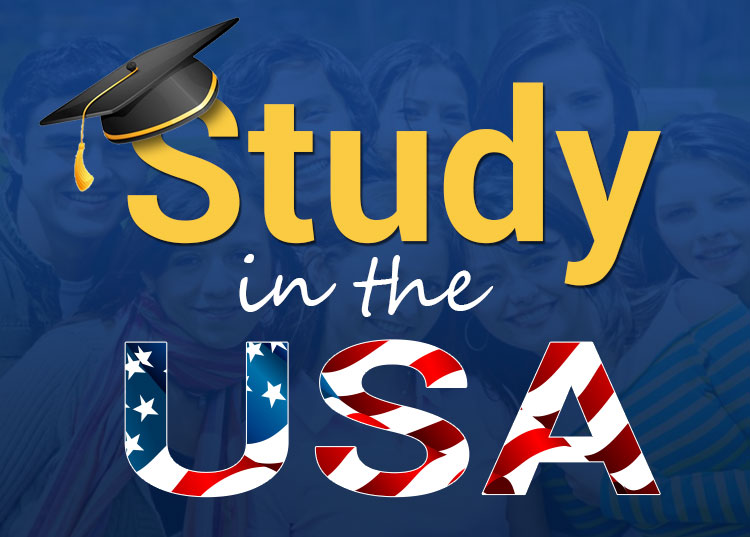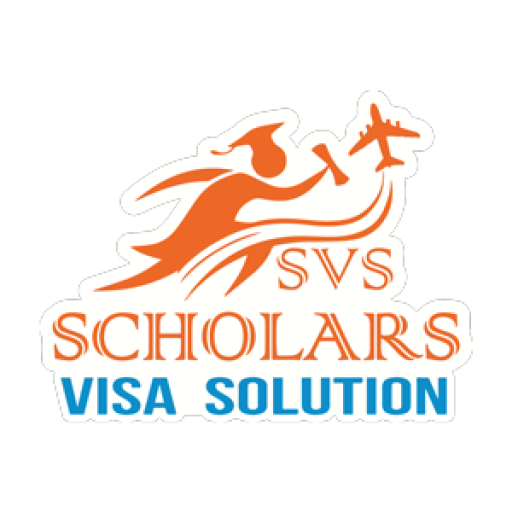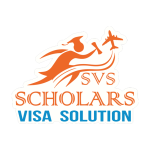Study In USA
About USA
The US is the third largest country in the world by land area and population. It’s located in North America between Canada in the north, and Mexico in the south. It’s bordered by the Pacific ocean on the west coast, and the Atlantic ocean on the east coast. Alaska (on the northwest tip of North America and bordered by Canada on the east), and Hawaii (an island in the Pacific ocean) are also US states. The capital of the US is Washington D.C., which isn’t officially part of any state, but rather an official government city between Maryland and Virginia. There are 50 states in the US, and they vary in size.
The weather and climate varies depending on where you live in the US because it’s so large and spans a diverse area of geographic landscapes. We’ve divided the US into four regions to simplify the different weather conditions across the states: West, Midwest (coldest), South, and Northeast

Why Study In USA?

- World class institutes
- International opportunities
- Diverse society
- Support for international students
- Conversational, broad-based education
- Wide variety of programs to study
- Unique culture
- Flexible study programs
- Be highly sought after by employers
Post-Graduation work (PGWP) and settlement in USA.
Most international students studying in the US will have an F-1 visa, which allows students to work on campus. Students can only work off campus if they participate in Curricular Practical Training (CPT). They can also work off campus through Optional Practical Training (OPT) during and after the completion of their studies.
- On-campus employment:
- F-1 students who’d like to work on campus must adhere to the following conditions:
- The student must maintain F-1 status while employed.
- Students can work up to a maximum of 20 hours per week during school.
- Students can work full-time on holidays and study breaks, but only if they intend to enroll in the upcoming semester.
- The student’s employment can’t remove a job opportunity from a US resident.
- Curricular Practical Training (CPT)
- CPT authorization has to follow specific conditions:
- The training must be directly related to the student’s field of study
- The training must be integral to the school’s curriculum
- The training must be completed before the student completes their degree program
- Authorization is for one employer during the specified period of training
- The training opportunity must be secured before applying for authorization
- One full year of CPT eliminates a student’s eligibility for OPT
- Severe economic hardship
- A student must meet these requirements in addition to experiencing severe economic hardship:
- The student must have been enrolled in studies for at least nine consecutive months or one academic year and be in good academic standing
- The student must be unable to obtain on-campus employment, or the compensation from on-campus employment isn’t enough to cover the student’s needs
- Employment / internship with international organization:
Once the student obtains a written offer, they can begin their application process for authorization of employment. Students are eligible to apply if they meet the following criteria:
- The student has a written offer of employment or internship from a recognized international organization
- The student must maintain their F-1 status and be enrolled in full-time studies
- Other Work Permits
- The H-1B:
This popular postgraduate pathway visa allows graduates to gain employment in a specialty occupation, such as a Department of Defense (DOD) Researcher or Development Project worker, a Specialty Occupation worker, or as a Fashion Model. International students can apply under the Specialty Occupation classification if they have a bachelor’s degree in a highly specialized field. For example, STEM graduates with specialized training are great candidates for an H-1B Specialty Occupation visa. Eligibility varies widely depending on the graduate’s occupation, but H-1B visa holders generally need to meet the following criteria to apply:
- A US employer must sponsor the applicant
- They must have a bachelor's degree or equivalent
- There must be a correlation between the job duties and the applicant’s educational and work experience
H-1B visa holders can generally work in the US for up to three years, and may be able to extend it to six years. H-1B visa holders may bring their dependents with them under H-4 visa status
- EB-5 Visa :
EB-5 Visa or Immigrant Investor Visa Program: The Immigrant Investor Visa Program is available to a foreign national who makes a one-time investment of at least US$900,000 in a US venture identified as an EB-5 business project. Applicants in the EB-5 program are eligible for a Green Card and conditional permanent residency for themselves and their immediate family. Be sure to check the US Citizenship and Immigration Services website for details.
International students with an EB-5 visa can work and study as permanent residents. Other benefits include the following:
- No restrictions on fields of study or work while studying
- Qualification for reduced in-state tuition fees at many universities
- Opportunity to apply for US citizenship after five years of conditional permanent residence
- Increased financial aid accessibility including loans and scholarships
- Paths to Permanent Residence
- PRIORITY WORKERS:
This category includes applicants who have the following characteristics:
- Advanced abilities in sciences, arts, education, or business fields
- Athletes with national or international acclaim and recognized achievements in their field
- Outstanding professors or researchers
- Certain multinational executives or managers
- PROFESSIONALS:
Applicants in this category need to hold an advanced degree or have an exceptional ability in the sciences, arts, or business. The job offer requirement may be waived for certain applicants if it’s of national interest.
- SKILLED WORKERS:
Applicants or their employers must petition for the applicant by obtaining a labour certification from the Department of Labour to file their Form I-140 for this category. If the Department of Labour has already determined there’s a labour shortage in the applicant’s area of work, they don’t need this certification and can move forward with their application
- EMPLOYMENT CREATION:
Applicants who are making investments in a new business in the US may qualify under this category by filing Form I-526.
This category includes applicants who have the following characteristics
Course to study in USA
Colleges
•Institutes of Technology ,
•Religious Schools,
•Technical Vocational college
These institutions are more trade-focused and grant two-year associate degrees in fields like electronics, the culinary arts, or automotive technology
Universities:
• Master of Engineering (MEng)
• Master of Science in Engineering (MS) • Doctor of Philosophy in Engineering (PhD)
• Master of Business Administration (MBA) • Master of Science in Finance (MSF)
• Master of Science in Nursing (MSN)
•Doctor of Nursing Practice (DNP)
Students interested in post-secondary study abroad options in the US can choose from various types of programs, including:
• Bachelor’s degrees
• Master’s degrees
• Doctorate degrees
• Undergraduate and Graduate Certificate programs
• Non-degree programs
Application Deadlines
Application Deadlines
Admission Requirement
- Admission Requirement undergraduate program
- GPA:
Colleges will assess students’ grades and grade point average (GPA) for admission. Traditional unweighted GPAs are scored on a scale of 0 to 4.0, while weighted GPAs are more complex and scored on a scale of 0 to 5.0.
- SAT and ACT:
The Scholastic Assessment Test (SAT) and the American College Test (ACT) are national standardized tests used for college admissions. International students may not be required to take an SAT or ACT. These are timed tests that are typically taken in a student’s junior or senior year of high school and test their abilities in reading, writing, and math.
- English Language:
Most universities require students to have a high-level of English language proficiency. There are multiple test options for students that test students’ reading, listening, speaking, and writing abilities.
The Test of English as a Foreign Language (TOEFL) is the most widely accepted among US schools, but some also accept the International English Language Testing System (IELTS) and Duolingo.
- Personal Essay:
The personal essay is an important part of a student’s college application. It’s a chance for students to explain why they want to study at the school they’ve chosen, and why they want to take their specified program.
Students can reflect on their extracurricular activities, hobbies and interests, work and volunteer experiences, and influential people that have impacted their decision.
- Admission Requirement Graduate program
- Graduate Management Admission Test (GMAT):
The GMAT is a common admission test for students who are entering an MBA or other business graduate program. The exam assesses students’ general verbal, mathematical, and analytical writing skills.
- Graduate Record Examinations (GRE):
The GRE measures students’ ability to succeed at graduate-level studies. This exam is one of the primary factors that admissions officers look at when deciding whether to accept students into the program.
Applicants in this category need to hold an advanced degree or have an exceptional ability in the sciences, arts, or business. The job offer requirement may be waived for certain applicants if it’s of national interest.
- Law School Admissions Test (LSAT):
The LSAT is a requirement for any students who are planning on entering law school. The LSAT often carries a lot of weight for most admissions offices.
- Medical College Admission Test (MCAT):
The MCAT is a standardized exam and admission requirement for prospective medical school students. The test is designed to test a student’s problem solving skills, critical thinking skills, and verify their analysis and knowledge of scientific principles including physical sciences and biological sciences.
- Dental Admission Test (DAT):
The DAT is an admission test for students wishing to enter a dental education program. It’s a multiple choice test and assesses students on scientific information, perceptual ability, reading comprehension, and quantitative reasoning.
Scholarships and financial support

- Internal Scholarships:
The best place to begin searching for a scholarship is the student’s school. Some colleges and universities have scholarship programs that can support international students, and nearly all colleges and universities offer program-specific scholarships as an option for all students.
Students can reflect on their extracurricular activities, hobbies and interests, work and volunteer experiences, and influential people that have impacted their decision.
- Teaching and Research Assistantships:
Many schools offer teaching and research assistantships to eligible students in their field of study. These assistantships provide invaluable experience in the student’s field of study, and they’re often paid positions to help students support themselves through school.
Visit internationalscholarships.com(opens in a new tab) to explore more scholarship opportunities for international students in the US.
- External Scholarships:
Students can also apply to external scholarships for additional financial aid. These scholarships are awarded by the government or private organizations to foster international student growth and support.
Visit internationalscholarships.com(opens in a new tab) to explore more scholarship opportunities for international students in the US.
What you will need when applying to a USA university or college for visa?
- Only US Citizenship and Immigration Services (USCIS) officers or immigration lawyers can provide students with official immigration information.
- Students interested in studying in the US should know that they must return to their home country after their studies, but there may be opportunities for a visa extension and post-study options for certain programs or specific professional fields of study.
- The Student and Exchange Visitor Program (SEVP) is part of the Department of Homeland Security and provides approval and oversight to schools that are authorized to enroll F and M visa nonimmigrant students.
- Types of Student Visas
- F-1 VISA:
The F-1 visa is for students who are attending an approved academic institution. F-1 students must maintain the minimum course load for full-time student status.
- F-1 students can work on campus, or participate in Curricular Practical Training (CPT), and Optional Practical Training (OPT).
- Students have to have evidence of sufficient funds to pay for all tuition and living expenses.
- F-1 students might be able to change their major or program of study.
- Students can stay in the US for up to 60 days after their program ends as indicated on their Form I-20 unless
- M-1 VISA:
The M-1 visa is for non-academic or vocational studies for a full course of study. A full course means studying at a community college or junior college with at least 12 semesters or quarter hours.
- J-1 VISA:
The J-1 visa is a nonimmigrant visa for students who wish to take part in a work-study based exchange program in the US. Students must first apply and be accepted into an exchange visitor program through a designated sponsoring organization.
How to Apply for a Student Visa
Once a student has been accepted into a SEVP-approved school, and the student accepts their offer, they’ll be registered in SEVIS and must pay the SEVIS I-901 fee. The school will then issue a Form I-20 directly to the student.
- STEP BY STEP:
- Step 1:
Students apply for their visa online using Form DS-160 and pay the non-refundable application fee of approximately US$160. Students will also need to upload a photo and must print a hard copy of the form confirmation page to bring to their interview.
- Step 2:
Students must provide the Form I-20 issued by the school if they’re applying for an F-1 or M-1 visa, or provide the Form DS-2019 issued by the student’s sponsor if they’re applying for a J-1 visa.
- Step 3:
Students must provide a valid passport. The student’s passport must be valid for at least six months beyond their stay in the US.
- Step 4:
Students need to provide academic documents, including transcripts, diplomas, or degrees from past schools, and any standardized test scores required by the US school the student will be attending.
- Step 5:
Students require proof of funds and financial ability to pay for all educational, living, and travel costs for the duration of the program. The amount of funds required will be indicated on the student’s Form I-20.
- Step 6:
Students need proof of intent to leave the US after they’ve completed their program of study. For example, a job offer or documents from a company the student wants to work for in their home country can be used as proof of intent to leave as well as the birth certificates of a partner or family members back home, personal assets, or bank records.
- Step 7:
Students are required to attend a visa interview with the exception of students age 13 and under, or 80 and over. Interviews are held at the US Embassy or Consulate in the student’s home country. Students will meet with a consular officer to determine whether they’re qualified to get a student visa. Here are some typical questions that are asked during the interview:
- What are you going to study at university?
- Why did you choose to study in the United States?
- Why did you choose this school?
- What have you done to prepare for this?
- What's your academic background?
- How will your studies be financed?
- What will you do after you graduate?
By following all the required steps, students will have the best chance of a successful student visa application.
It’s important to note that only certified immigration professionals can give immigration advice. Students should visit the US Department of State(opens in a new tab) website to determine which visa is most appropriate for them and to check any restrictions or additional requirements that are attached to the visa.
Visa Application Processing Times
- Students should apply for their visa as soon as possible and well in advance of their program start date. Processing times can vary depending on the student’s home country, personal circumstances, administrative processing, and individual applications.
- M-1 and F-1 visas can be issued up to 120 days in advance of the program’s start date, but the overall process can take six months or longer. Students may be able to expedite their interview date if there are urgent, unforeseen circumstances such as a funeral, medical emergency, or change to a program’s start date.
When flying to USA students are required to do the following
- Application Approvals
- Students can start planning their trip to the US once their visa is approved. Students aren’t allowed to enter the US more than 30 days before the program start date stated on their Form I-20.
- If their visa is approved, digital fingerprint scans will be taken for records, and the student’s original documents will be returned to them after the interview. Students will sometimes be notified to pick up their passport, or it’ll be mailed back to them. Students may also have to pay a visa issuance fee depending on their nationality.
- Application Rejections
If a student’s visa is denied, it’s based on US immigration law. The reason for denial will be provided to the student in the paperwork. Some of the most common reasons for denial are as follows:
- Failure to prove strong ties to their home country and intent to leave after their studies
- Fraud or misrepresentation
- Health-related reasons
- Criminal or security-related reasons
- Failure to provide necessary supporting information or documents
INSTITUTES IN USA
University | University Name | Apply Now |
 | Avila University | |
 | Full Sail University | |
 | Gannon University | |
 | Lincoln University | |
 | Mercy College | |
 | Metropolitan College of New York | |
 | Trine University | |
 | ||
 | ||
 | Webster University | |
 | Westcliff University |

